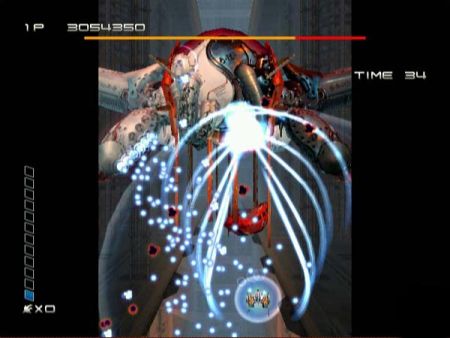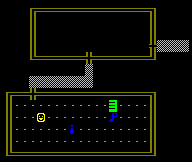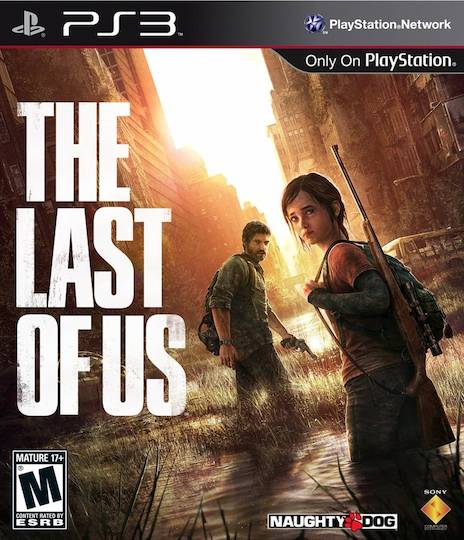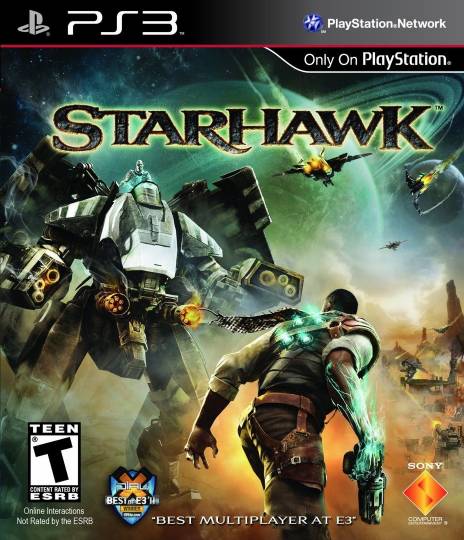
Back in April, there was a lot of excitement around the rerelease of a game called Ikaruga on Xbox Live Arcade. The game seemed to have garnered praise from all corners, including many people whose opinions I’ve come to greatly respect. My anticipation grew, and when the game was finally released I immediately jumped on my console to give the demo a whirl.
I was dismayed, this is the game everyone was excited about? It was brutally difficult and I had burned through my lives in no time at all. It seemed the only way to advance was to play the same section over and over until you had memorized the enemy attack patterns and developed an extremely itchy trigger finger. In other words, it felt like every other 2D shoot ’em up game (commonly labelled a shmup) I had every played, albeit with very pretty graphics and an interesting polarity mechanic.
This experience left me a little confused. It wasn’t the difficulty issue that threw me off, I’m well aware that there are those who still love brutally challenging titles. However, for reference, Triggerheart Exelica, an equally difficult shmup, had been rereleased on XBLA two months earlier to little fanfare in the general gaming community. Ikaruga‘s mean review score was 25% higher than Triggerheart Exelica‘s, but the games seemed extremely similar to me. Why was Ikaruga apparently a vastly superior title? Why couldn’t I see it?
I struggled with this for a little while, and challenged whoever would listen to expose the game’s hidden greatness to me in clear terms. The answer finally came from a fellow named The Ghost, who wrote an audio blog [mp3] that directly addressed my confusion. In it, he said the following:
If you don’t want to play the same level over and over again, trying to perfect your run and really learn the game you’re not going to like this game. […] If you don’t want to step up to the challenge, you’re going to miss a lot of the little details that make the game really great, like how the bullet patterns are set up, the strategy to building chains, how many enemies come at you. The strategy and the level of thinking that goes into a solid run of something like Ikaruga […] is pretty intense, and it has a huge reward at the end of it.
He went on to explain:
If dying over and over again doesn’t sound like a good time to you (and I can understand why it wouldn’t) then the game’s not going to seem that good, because you’re not going to have all those extra elements that actually make it endearing and fun and interesting and really appreciate the design. It’s going to seem like just another shmup, just another of these millions and millions of shmups out there. It’s not going to seem special or anything like that. Once you do get into it, the way it’s designed is superb, top of the game, great example of what a shmup can be when it’s really well designed and thought out.
The answer was clear: since I am not a shmup fan, I can neither see nor appreciate the small details that make Ikaruga so great. I believe there are two dimensions to this lack of understanding:
- Context: Having played very few shmups, I don’t have the context with which to compare Ikaruga to other games in the genre. I can’t grep the differences to figure out what they did differently.
- Depth: Because my skill and interest levels are so low, the depth of the game’s mechanics are lost on me. I can’t appreciate the difference between a clever enemy attack pattern and an obvious one.
 Here’s another example: one of my favourite columns over at GameSetWatch is John Harris’ @ Play series. It features in-depth discussions about a niche subset of retro RPGs called roguelikes, named after the influential PC game Rogue released in 1980. To quote Mr. Harris:
Here’s another example: one of my favourite columns over at GameSetWatch is John Harris’ @ Play series. It features in-depth discussions about a niche subset of retro RPGs called roguelikes, named after the influential PC game Rogue released in 1980. To quote Mr. Harris:
Roguelikes are dungeon-exploration computer games […] set in a randomly-generated world. They are known for their tremendous difficulty, unpredictability, permanent character death, and the large number of methods they use to inflict that death. They were most popular in college computer labs in the 80s, and while they never achieved widespread success, the genre nevertheless persists to this day, and its dedicated cadre of devotees will argue night and day that these are the greatest computer games ever made.
The column is fascinating because of the writer’s encyclopedic knowledge of roguelikes, which he uses to discuss their history, mechanics, bestiaries and enduring fan-base. However, some of his most interesting columns set about deconstructing roguelikes that didn’t quite work.
Take for instance his thorough critique of Izuna: Legend of the Unemployed Ninja. In it, he penalizes the game for allowing the player to preserve XP and items upon dying, which breaks a fundamental element of roguelike design and introduces grind. He also discusses how Izuna does away with the traditional food requirement in favour of other mechanics (such as weapon durability) with mixed results. His expertise in the genre gives his insight as to the small details that differentiate a decent roguelike from a great one.
 One final example of this would be the lukeward reception of Halo 3 by some of my game blogging colleagues. I don’t wish to insult their judgement, as they make up a large portion of the previously mentioned “people whose opinions I’ve come to greatly respect.” Their comments about the lackluster storytelling, excessive launch hype and inflated reviews are certainly valid. However, as a huge fan of console shooter I can’t help but feel that they may have missed some of the small details that make Halo 3, gameplay-wise, the cream of the console shooter experience.
One final example of this would be the lukeward reception of Halo 3 by some of my game blogging colleagues. I don’t wish to insult their judgement, as they make up a large portion of the previously mentioned “people whose opinions I’ve come to greatly respect.” Their comments about the lackluster storytelling, excessive launch hype and inflated reviews are certainly valid. However, as a huge fan of console shooter I can’t help but feel that they may have missed some of the small details that make Halo 3, gameplay-wise, the cream of the console shooter experience.
Neither of the Halo sequels has brought about the same dramatic revolution that the “golden tripod” (weapon, grenade, melee) did back in 2001. However, each has brought about their own small changes that helped to further refine and expand the already stellar experience. In the case of Halo 3, they managed to finally completely balance their armoury, while at the same time nearly doubling its size. Furthermore, the equipment system (bubble shield, regenerator, etc.) added a fourth leg to the player’s toolset without sacrificing balance or control convenience. It’s these small details that make the difference between a great console shooter and a mediocre one (ex: Team Fortress 2 on the Xbox.)
Despite my digression, the point I’m trying to emphasize (with the cunning use of bold) is that unless you’re experienced with a genre, it’s very difficult to notice the small details that seperate a decent game from a great one. If you’ve ever been tempted to call a popular game “overrated”, it might be worth shifting your paradigms with this in mind.





July 27th, 2008 at 8:48 pm
I couldn’t agree with you more about Halo 3 and the whole small details issue. That said, I empathise with people who don’t see the details because I for one have been guilty of that on numerous occasions with other titles.
Great summary of the issue.
July 27th, 2008 at 7:53 pm
A couple of months ago I wrote a post proposing a continuum that measures how “video-gamey” a game is. I’ll excerpt it here:
“I think of the two ends of this one as “accessibility” and “self-reflexivity,” which are perhaps not ideal terms, but they’ll do for now. Way at the accessibility extreme are titles like Wii Fit and Brain Age, which use the language of video games but otherwise barely qualify as such. Next to them are games like Wii Play and Mario Party, which are more traditionally “video-gamey” but don’t require a deep familiarity with the medium to enjoy. Moving down the line we encounter genres that are increasingly built upon gaming expertise: real-time strategy games, tactical RPGs, 4X games, MMORPGs. Finally, on the self-reflexivity end is your No More Heroes and You Have to Burn the Rope. For these titles, the mechanics aren’t the issue — their very appeal is limited to those steeped in the culture.”
I later relented on the self-reflexivity angle in favor of hardcore games in general (and actually gave Ikaruga as a possible example), but I think the point is the same — sometimes a game is only interesting to people already experienced with the medium or genre. I think your argument about the importance of small details explains why that is so.
July 28th, 2008 at 9:15 pm
@Dan:
I like how you connected these two ideas, some genres are inherently more or less accessible than others. You don’t really need any experience or context to enjoy Wii Sports or Bejewelled, for instance.
Since writing the post, I’ve considered that this paradigm can really be applied to any medium. A layman can’t really tell the difference between Joshua Bell and a busker, for instance. I suppose I had just never run into this problem with video games before.
@Ben:
Thank you! Unfortunately I think a lot of the appreciation for Halo’s mechanics (especially the “golden tripod”) comes from multiplayer, which many gamers aren’t interested in participating in.
July 30th, 2008 at 8:31 pm
A few months ago I decided to get into shmps after reading so much praise for Treasure (the developers) on one of my favourite retro gaming blogs. Before then my last experience of the genre was with R-type on the Amiga 500.
My experiences differed greatly from your own though and right off the bat I found Ikaruga to be incredible. What made me enjoy the game so much was how refined (to the state of perfect) the pattern recognition was and how the polarized gameplay impacted on your play stratergies. I discovered that because of these mechanics being so finely tuned, Ikaruga fed into my subconcious almost from the instant I started playing. While people talk about the game being hard (I have never understood this and yet I too am new at shmps), I find that because it requires such a pristine level of concerntration I always slip out of my mindset and find the experience to be highly euphoric.
Recently I ploughed through Gradius I-IV + Gaiden on Gradius Collection (PSP) and I did not feel the same way at all. While the games were enjoyable, they were more inhumanely difficult and frustrating, like most shmps, I suppose. Not balanced like Ikaruga.
July 30th, 2008 at 9:58 pm
@Daniel
That sounds like a terrific experience, I’m sure that trance-like state is a big part of why the game is so revered. Some people thrive under such high reflex demand conditions, but I’m afraid I’m simply not one of them.
Thanks for the comment, you write a great blog yourself.